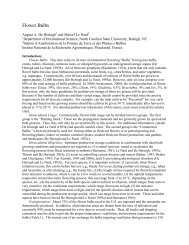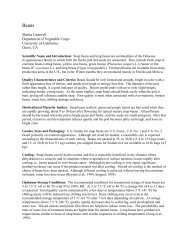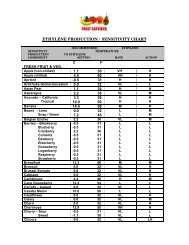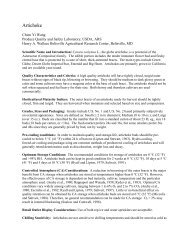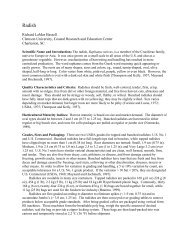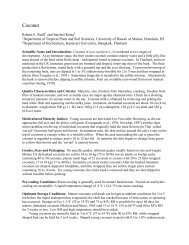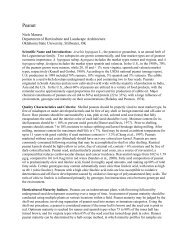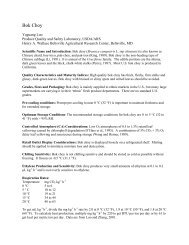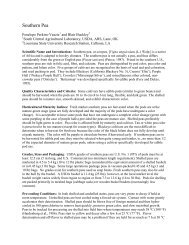Hazelnuts
Hazelnuts
Hazelnuts
- No tags were found...
Create successful ePaper yourself
Turn your PDF publications into a flip-book with our unique Google optimized e-Paper software.
HazelnutNiels ManessDepartment of Horticulture and Landscape ArchitectureOklahoma State University, Stillwater, OKScientific Name and Introduction: Corylus avellana L., the filbert or hazelnut is a member of the birchfamily (Betulaceae). The edible seed is surrounded by a round to slightly oblong shell that must beseparated from a husk during or after harvest. All important world cultivars originated from humanselections of wild C. avellana in Europe and Turkey. The common name “filbert” originated in Englandand was originally applied to the long husked types of Corylus avellana to distinguish them from theshort husked types, and has since been used in the U.S. to distinguish the cultivated Corylus avellanafrom other native wild species of Corylus. The common name “hazelnut” is more commonly appliedworld-wide, for nuts produced by all Corylus species and will be most commonly used in theseguidelines.Two wild species, C. americana and C. cornuta, are found in the U.S. C. americana has been used inbreeding programs for crossing with C. avellana in attempts to provide genotypes with sufficient coldhardiness and eastern filbert blight tolerance or resistance to allow production east of the RockyMountains with some success. Whatever the chosen common name, nuts from this genera represent oneof the world’s major nut crops, second only to almonds (Thompson et al., 1996). Turkey produces mostof the world supply (70%), followed by Italy (22%), Spain (5%) and the U.S. (3%). By far the largestproduction area in the U.S. is the Pacific northwest, with 99% of production occurring in the WillametteValley of Oregon (Mehlenbacher and Olsen, 1997). Market uses for the U.S. crop has been roughlyevenly divided between in-shell and kernel markets, but trends are shifting towards kernel markets. Themajor variety in the U.S. is Barcelona, followed by Davinia, Ennis and Willamette.Quality Characteristics and Criteria: In-shell hazelnuts should be properly sized to meet the statedmarket type and should be properly filled with at least 50% of the shell cavity occupied by nutmeat.Shells should be free of cracks and noticeable mechanical injury, clean, brightly colored and coloringpatterns should be characteristic of the stated variety. The pellicle should be smooth and devoid of huskattachments. Kernels should meet the stated market type, be free of any misshapen or underdevelopedkernels and be free of any shell or foreign material and off-odor, off-flavor or mold. Water content ofkernels should not exceed 6% if shelled or 7% if in-shell, and the total water content of unshelled nutsshould not exceed 10 to 12%. Size is specified with grade as a determinant of quality, and minimum sizesare used for specification of classes “Extra” and “Class I” in international trade. For in-shell markets,larger and particularly rounded types are preferred. Shelled markets accommodate both rounded andoblong types, and size preference is dependent on the intended end use. Hazelnut kernel oil contentranges from 57 to over 70% and total sugars average about 4% and both vary with variety and growinglocation (Botta et al., 1994). <strong>Hazelnuts</strong> are highest among tree nuts in α-tocopherol content (366 µg/g oil)and are also a rich source of vitamin B 6 (0.54 to 0.89 mg per 100 g) (Richardson, 1997).Horticultural Maturity Indices: In areas where hazelnuts are mechanically harvested, nuts are usuallyallowed to naturally drop from trees prior to sweeping from the orchard floor, and harvesting maycommence after 90% of the nuts have dropped (Lagerstedt, 1979). Kernels are considered mature afteroil accumulation is complete and when the nut detaches from the base of the husk (Thompson et al.,1996). In the U.S., most nuts are mature during or by the end of August, but may be prevented fromdropping by an immature, clasping husk. In production areas where hand harvest from trees is stillpracticed, or for varieties in which husks fail to open and allow nut drop, nuts are considered maturewhen they will rattle inside the husk, indicating detachment of the nut from the base of the husk.
Grades, Sizes and Packaging: U.S. standards exist for filberts in the shell, and for importation of inshellor shelled hazelnuts, and international UN/ECE standards exist for both in-shell and shelledhazelnuts. Grades are primarily determined by size, degree of kernel fill, color and freedom from defectsand foreign material. U.S No. 1 filberts must contain no more than 20% filberts of a different type (roundshaped versus long type); no more than 10% defective nuts, provided that no more than 5% are poorlyfilled (blanks), no more than 5% are rancid, decayed, moldy or insect injured and no more than 3% areinsect injured; not more than 15% filberts that fail to meet the specified size and of which no more than10% are undersized; shells are free from surface moisture and the combined shell and kernel moisturecontent is not greater than 10%; shells are well formed, unbroken, not discolored, have adhering huskcovering not more than 5% of the shell area and practically free of adhering dirt and other foreignmaterial.Size is specified in connection with the grade in terms of minimum and maximum diameters whichwill pass through round openings of a screen and are specified separately for round-type varieties versuslong-type varieties. For round-type varieties, Jumbo nuts are those which will not pass through a 56/64 in(22.2 mm) round opening; Large nuts will pass though a 56/64 in (22.2 mm) opening but will not passthrough a 49/64 inch (19.4 mm) opening; Medium nuts will pass through a 49/64 inch (19.4 mm) openingbut will not pass through a 45/64 in (17.9 mm) opening; Small nuts are all nuts which will pass through a45/64 in (17.9 mm) opening. For long-type varieties, Jumbo nuts are those which will not pass through a47/64 in (18.6 mm) opening; Large nuts will pass through a 48/64 inch (19.0 mm) opening but will notpass through a 44/64 in (17.5 mm) opening; Medium nuts will pass through a 45/64 inch (17.9 mm)opening but not through a 34/64 in (13.5 mm) opening; Small nuts will pass through a 35/64 in (13.9 mm)opening.All hazelnuts imported into the U.S. in lot quantities which exceed 115 lb net weight must meetminimum grade standards as specified under section 8e of the Agricultural Marketing Agreement Act. Inshellhazelnuts must meet U.S. No. 1 grade and be at least medium size with a tolerance for insect injuryof 2% or less. Shelled hazelnuts must be well dried and clean, free from foreign material, mold, rancidity,decay or insect injury and free from serious damage caused by serious shriveling or other means. Statedtolerances for shelled hazelnuts include not more than 0.0002% foreign material, not more than 5% ofkernels or pieces of kernels which are below grade, including not more than 2% for mold, rancidity,decay or insect injury, and no more than 1% with, rancidity or insect injury.International grade standards are exercised at the export control stage and are specified for both inshelland shelled hazelnuts. For in-shell nuts, UN/ECE classifications of Extra, Class I and Class II existin which the shell of all nuts must be well formed, intact, sound and clean and the kernels must be sound,clean, sufficiently developed, free from: mold, visible damage from insects or pests, presence of live ordead insects or pests, rancidity, foreign smell or taste, and blemishes. All hazelnuts must contain lessthan 12% moisture and kernels not more than 7% moisture, and foreign material may not exceed 0.25%of the total in-shell weight. Sizing and statement of variety, commercial type or shape is compulsory forExtra and Class I but is optional for Class II. For specified sizes in nuts of all classes, a total tolerance bycount of 5% for rounded types and 10% for oblong types for nuts not meeting the specified size isallowed. Extra hazelnuts must be 16 mm in diameter or more and be of superior quality, must becharacteristic of the variety and/or commercial type, must be practically free from defects with theexception of very slight superficial defects provided they do not affect the general appearance, quality orkeeping quality. They must contain not more than 4% empty nuts on a count basis, not more than 3% ofthe weight of in-shell nuts may contain shell defects, not more than 5% of the kernels may be defectiveand of which not more than 3% may be moldy, rotten, rancid or damaged by insects. Class I hazelnutsmust be 14 mm in diameter or more and be of good quality, must be characteristic of the variety and/orcommercial type, may contain only slight defects provided they do not affect the general appearance,quality or keeping quality. They must contain not more than 6% empty nuts on a count basis, not morethan 5% of the weight of in-shell nuts may contain shell defects, not more than 8% of the kernels may be
defective and of which not more than 5% may be moldy, rotten, rancid or damaged by insects. Class IIhazelnuts may be of any size (if size is specified, tolerances apply) and be of marketable quality, maycontain defects provided that the in-shell nuts retain their essential characteristics as regards generalappearance, quality and keeping quality. They must contain not more than 8% empty nuts on a countbasis, not more than 7% of the weight of in-shell nuts may contain shell defects, not more than 12% of thekernels may be defective and of which not more than 6% may be moldy, rotten, rancid or damaged byinsects. Sizing or screening is used to specify market size in 2 mm increments from 22 mm to 14 mm orless. Sizing for nuts less than 22 mm diameter must include the maximum and minimum size range, or bymentioning the minimum size followed by the words “and over,” or the maximum size followed by thewords “and less.” For nuts for final consumers under the classification “screened,” the size “and less” isnot allowed.For hazelnut kernels, UN/ECE classifications of Extra, Class I and Class II also exist andrequirements are similar to those stated for kernels of in-shell nuts with the addition of provisions forintactness of kernels and a slightly reduced tolerance for kernel moisture content from not more than 7%for in-shell kernels to not more than 6% for shelled kernels. Foreign material may not exceed 0.25% forkernels in any classification. Sizing and statement of variety is also compulsory for Extra and Class Ikernels, but optional for Class II. For kernels in all classes, a total tolerance of 10% is allowed for kernelsother than the specified variety and/or type, and a size tolerance by weight of 5% is allowed for roundedtypes and of 10% for oblong types. To be designated either Extra or Class I, hazelnut kernels must have aminimum diameter of 9 mm, with the exception of hazelnuts of the piccolo type or hazelnuts having asimilar designation for which a diameter of from 6 to 9 mm is allowed. Extra hazelnut kernels must be ofsuperior quality, must be characteristic of the variety and/or commercial type and must be practically freeof defects with the exception of very slight superficial defects provided they do not affect the generalappearance, quality or keeping quality. Total tolerances for defects are 5% by weight or 6% if the lot isspecified as “Old Crop.” Of the total tolerance, no more than 1% may be rancid, rotten, moldy, have offodor or off flavor or be damaged by insects or rodents; no more than 2% may be not fully developed,including shrunken and shriveled, stained and yellowish kernels; not more than 3% may be mechanicallydamaged and pieces. Not included in the total tolerance, not more than 2% may be twin hazelnuts. ClassI hazelnut kernels must be of good quality, must be characteristic of the variety and/or commercial typeand may have slight defects of form and color, provided that these do not affect the general appearance,quality or keeping quality. Total tolerances for defects are 12 to 13% if the lot is specified as “Old Crop.”Of the total tolerance, no more than 1.5% may be rancid, rotten, moldy, have off odor or off flavor or bedamaged by insects or rodents; no more than 4% may be not fully developed, including shrunken andshriveled, stained and yellowish kernels; not more than 8% may be mechanically damaged and pieces.Not included in the total tolerance, not more than 5% may be twin hazelnuts. Class II hazelnut kernelsmay be of any size (if size is specified, tolerances apply) and be of marketable quality, may containdefects provided that kernels retain their essential characteristics as regards general appearance, qualityand keeping quality. Total tolerances for defects are 16 to 18% if the lot is specified as “Old Crop.” Ofthe total tolerance, no more than 3% may be rancid, rotten, moldy, have off odor or off flavor or bedamaged by insects or rodents; no more than 8% may be not fully developed, including shrunken andshriveled, stained and yellowish kernels; not more than 10% may be mechanically damaged and pieces.Not included in the total tolerance, not more than 8% may be twin hazelnuts. Sizing for hazelnut kernelsmay be by sizing or screening and is expressed in increments of 2 mm. All sizes are allowed, subject tothe minimum designations for Extra and Class I hazelnut kernels. For kernels for final consumers underthe classification “screened,” the size “and less” is not allowed.Optimum Storage Conditions: Soon after harvest nuts should be dried to below 10 to 12% moisture,with kernels below 6 to 7% moisture to deter mold growth. In-shell and un-roasted kernels may be storedfor 24 mo with minimal loss in quality at temperatures up to 10 °C (50 ºF). Roasted kernels may only beheld for 6 mo prior to development of detectable rancidity stored at 0 °C, 5 °C or 10 °C (32, 41, or 50 ºF).
However, reduced temperature may be effective in combination with other protective measures such asvacuum packaging in extending roasted kernel shelf-life to 1 year or more (Ebraheim et al., 1994).Retail Outlet Display Considerations: <strong>Hazelnuts</strong> are normally marketed at ambient temperature. Use ofvacuum or low O 2 MAP is recommended to extend shelf-life. In-shell hazelnuts may be marketed in bulkcontainers. Exposure to moisture and high RH should be avoided.Chilling Sensitivity: <strong>Hazelnuts</strong> are not sensitive to chilling temperatures and are commonly stored attemperatures at or below freezing for long term storage.Ethylene Production and Sensitivity: Ethylene may be used as a harvest aide to enhance maturation ofhusks for earlier harvest (Lagerstedt, 1979). During storage hazelnuts produce very low levels ofethylene.Respiration Rates: Properly dried hazelnuts exhibit very low respiration rates during storage.Physiological Disorders: Black tips on kernels appears to be associated with nuts having split or weaksutures. It appears to be caused by an oxidation process that occurs on the pellicle only, and may or maynot be associated with moldy kernels (Thompson et al., 1996). Twin kernels occur when two kernelsdevelop within one nut shell, and is an undesirable trait because of the small size and irregular shape ofaffected kernels. Blank nuts are in-shell hazelnuts devoid of normal kernels which result from defectiveembryo sacs, unviable eggs, failure of fertilization or embryo abortion at varying stages of development.Owing to the alternate bearing cycles for hazelnuts, poorly filled nuts may also result during anoverproduction year, and poor kernel fill appears to be a heritable trait (Thompson et al., 1996).Postharvest Pathology: The most common decay found in hazelnuts is molds, with Romulariaspp. most prevalent throughout nut development and the major pathogen associated with kernel tip mold(see p. 483 of Ebraheim et al., 1997). Although Romularia spp. appears to infect hazelnuts during nutdevelopment and may be quiescent prior to maturity and storage, many molds require breakage of theshell to contaminate the nut and thus intactness of the shell offers some natural defense against moldinfestation. The dominant fungal flora during storage is Penicillium and Aspergillus spp. A. flavus capableof producing aflatoxin has been isolated from hazelnuts in storage (Eke and Goktan, 1987). Reduction ofin-shell moisture content to below 10%, and nutmeat moisture content to less than 6% is an effectivemeans deterring mold growth. Sanitation with chlorine dips may also be effective in reducing theincidence of mold infestation by reducing the amount if innoculum carried into postharvest storage.Because of the high amounts of organic material on the surface of shells, chlorine concentrations shouldbe monitored and replenished as necessary to maintain chlorine at concentrations necessary to killmicroorganisms.Quarantine Issues: All trees, plants, cuttings and scions of all species and varieties of the wild andcultivated filbert or hazelnut, Corylus spp. may not be transported into Oregan from states and districts ofthe U.S. east of and including the states of Montana, Wyoming, Colorado and New Mexico; the entirestate of Washington, and all provinces, districts and territories of Canada east of and including theprovince of Alberta to prevent spread of Eastern Filbert Blight (Anisogramma anomala).Special Considerations: <strong>Hazelnuts</strong> marketed in-shell should be sampled periodically to assess nutmeatquality. Although the most common nut causing allergy in children and adults is peanut, hazelnuts mayalso be an allergenic food additive (Ewan, 1996) and the presence of hazelnut in foods must be declared.An ELISA test can be used to detect hazelnut presence in complex food mixtures (Holzhauser and Vieths,1999). Shelling, blanching and/or roasting decreases hazelnut shelflife as compared to storage in-shell
(Ebraheim et al., 1994). Roasting temperature and duration interact to decrease shelf-life with increasingroasting temperature and/or duration (Richardson and Ebraheim, 1997). <strong>Hazelnuts</strong> absorb lipophiliccompounds that can induce off-flavor. Although frozen storage may be used to increase shelf-life, onceout of storage hazelnuts should be utilized as soon as possible due to reduced shelf-life at roomtemperature.References:Botta, R., C. Gianotti, D. Richardson, A. Suwanagul and C. Sanz. 1994. Hazelnut variety, organic acids,sugars and total lipid fatty acids. Acta Hort. 351:693-699.Ebraheim, K.S., D.G. Richardson and R.M. Tetley. 1994. Effects of storage temperature, kernel intactnessand roasting temperature on vitamin E, fatty acids and peroxide value of hazelnuts. Acta Hort.351:677-684.Ebraheim, K., D.G. Richarson, J. Stone and R. Tetley. 1997. Hazelnut mold identification and timing ofinfestation. Acta Hort. 445:483-484.Eke, D. and D. Goktan. 1987. Aflatoxin production in hazelnuts. Ege Univeritesi Ziraat Fakultesi Dergisi24:289-297.Ewan, P.W. 1996. Clinical study of peanut and nut allergy in 62 consecutive patients: new features andassociations. Brit. Med. J. 312:1074-1078.Holzhauser, T. and S. Vieths. 1999. Quantitative sandwitch ELISA for determination of traces of hazelnut(Corylus avellana) protein in complex food mixtures. J. Agric. Food Chem. 47:4209-4218.Lagerstedt, H.B. 1979. Filberts. In: R.A. Jaynes (ed) Nut Tree Culture in North America, The NorthernNut Growers Assoc., Inc., Hamden, Conn., pp. 128-147.Mehlenbacher, S.A. and J. Olsen. 1997. The hazelnut industry in Oregon, USA. Acta Hort. 445:337-346.Richardson, D.G. 1997. The health benefits of eating hazelnuts: Implications for blood lipid profiles,coronary heart disease and cancer risks. Acta Hort. 445:295-300.Richardson, D.G. and K. Ebraheim. 1997. Hazelnut kernel quality as affected by roasting temperaturesand duration. Acta Hort. 445:301-304.Thompson, M.M., H.B. Lagerstedt and S.A. Mehlenbacher. 1996. <strong>Hazelnuts</strong>. In: J. Janick and J.N. Moore(eds) Fruit Breeding. Nuts. Vol. 3, John Wiley and Sons, NY, pp. 125-184.



